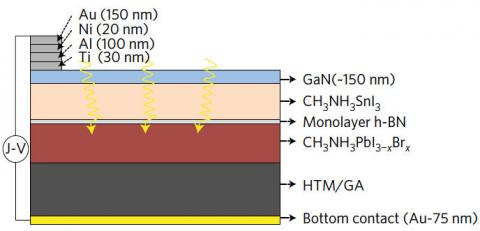Researchers from the University of California, Berkeley, and Lawrence Berkeley National Laboratory have developed a flexible perovskite solar cell that reaches an efficiency of 21.7%, a peak conversion efficiency of 26% and could be manufactured using a low cost roll-to-roll process.

Many previous attempts to merge two perovskite materials have failed because the materials degrade one another's electronic performance. This design was achieved using a new way of combining two perovskite solar cell materials ' each tuned to absorb a different wavelength or color of sunlight ' into one 'graded bandgap' solar cell that absorbs nearly the entire spectrum of visible light.
The key to combining the two materials into a tandem solar cell is a single-atom thick layer of hexagonal boron nitride, which looks like a layer of chicken wire separating the perovskite layers from one other. In this case, the perovskite materials are made of the organic molecules methyl and ammonia, but one contains the metals tin and iodine, while the other contains lead and iodine doped with bromine. The former is tuned to preferentially absorb light with an energy of 1 electron volt (eV) ' infrared, or heat energy ' while the latter absorbs photons of energy 2 eV, or an amber color.
The monolayer of boron nitride allows the two perovskite materials to work together and make electricity from light across the whole range of colors between 1 and 2 eV. The perovskite/boron nitride sandwich is placed atop a lightweight aerogel of graphene that promotes the growth of finer-grained perovskite crystals, serves as a moisture barrier and helps stabilize charge transport though the solar cell.
The structure is capped at the bottom with a gold electrode and at the top by a gallium nitride layer that collects the electrons that are generated within the cell. The active layer of the thin-film solar cell is about 400 nanometers thick.
'People have had this idea of easy-to-make, roll-to-roll photovoltaics, where you pull plastic off a roll, spray on the solar material, and roll it back up,' the researchers said. 'With this new material, we are in the regime of roll-to-roll mass production; it's really almost like spray painting.'
The team also states that the theoretical efficiency calculations should be much higher and easier to reach than for single-bandgap solar cells because it is possible to maximize coverage of the solar spectrum.
In October 2016, researchers at Stanford University and Oxford University have reportedly combined two perovskite materials to produce a stable solar cell with efficiency over 20% that can be printed on a plastic substrate.

